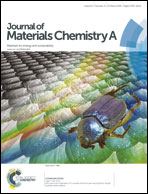An insight into the controllable synthesis of Cd(ii) complexes with a new multifunctional ligand and its application in dye-sensitized solar cells and luminescence properties†
Abstract
Based on a new design of 4-cyanobenzyl-based 1,2,4-triazole ligand 4-(1,2,4-triazolylmethyl) cyanobenzene (TMCB), a series of cadmium complexes 1–5′ from a mononuclear to three-dimensional (3D) structure have been synthesized through hydro(solvo)thermal reactions; they were generally formulated as [Cd(TMCBA)2]n (1), [Cd(TMCB)(1,4-bda)(H2O)]n (2), {[Cd2(TMCB)4(1,4-bda)2(H2O)2]n·3H2O}n (3), {[Cd(TMCB)4(H2O)2]·(NO3)2·(H2O)2}n (4), [Cd1.5(1,4-bda)1.5(DMF)2]2n (5) and [Cd1.5(1,4-bda)1.5(DMF)2]2n (5′) (TMCBA = 4-(1,2,4-triazolylmethyl) benzoic acid, which is formed from the hydrolysis of TMCB; 1,4-H2bda = 1,4-benzenedicarboxylic acid; the difference between two genuine supramolecular isomers of 5 and 5′ is the use of TMCB as the additive agent for the reaction). Complexes 1–5′ exhibit tunable luminescence with emission maxima containing deep blue, blue, light blue, green and deep green region at 298 K or 77 K in both different solvents (polarity: DMSO > CH3OH > CHCl3) and solid state. Interestingly, the good thermal stability accompanied by their compensated adsorption to ruthenium complex N719 in the region of low wavelength, enabled 1 and 4 to serve as co-sensitizers in combination with N719 in dye sensitized solar cells (DSSCs). After co-sensitization with N719, the overall conversion efficiency of 1 and 4 were found to be 7.68% and 6.85%, which are 40.40% and 25.23% higher than that for DSSCs only sensitized by N719 (5.47%) under the same conditions, respectively. The improvement in efficiency is attributed to the fact that complexes 1 and 4 overcome the deficiency of N719 absorption in the low wavelength region of ultraviolet and blue-violet, offset competitive visible light absorption of I3− and reduce charge recombination due to the formation of an effective cover layer of the dye molecules on the TiO2 surface. As a result, the synthesized complexes are promising candidates as co-adsorbents and co-sensitizers for highly efficient DSSCs.


 Please wait while we load your content...
Please wait while we load your content...